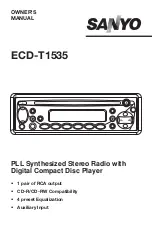
2.3
Selecting Functions With DIP Switches LIU-1 Through LIU-4
There are four LIU switches. The first switch will change the receive sensitivity from -26 dB to -36 dB.
Changing to -36 dB for extra long loops (1 mile) is not recommended unless the DXPT1 will not maintain
frame sync. In the -36 dB setting, noise could be a problem because of increased sensitivity.
The LIU-2 switch sets the transmit signal level. The transmit signal level has nothing to do with the audio
voice levels. The default is manual “on” and the transmit level is determined by LIU-3 and 4 settings.
LIU-3 and LIU-4 are defaulted “off” which corresponds to 0 dB (strong signal).
For applications where the DXPT1 is directly connected to a nearby repeater, the automatic mode is
preferred (LIU-2="off") to keep from over driving the repeater. Repeaters are very sensitive on their
inputs. In auto mode, the transmit is determined by the receive level according to the following chart:
LIU-3 and 4 are ignored in auto mode.
IF LEVEL RECEIVED IS
LEVEL TRANSMITTED IS
0 to -7.5 dB
-7.5 to -15 dB
-15 to -22.5 dB
-22.5 to -26 dB
-15 dB
-7.5 dB
-7.5 dB
0 dB
If in auto mode and LIU switch 3 or 4 is changed, a re-sync is required to reset the new setting.
Unplugging the T1 span in and out is an easy way to cause a re-sync.
2.4
Setting Up The DXOPT-SYN Synchronization Card
Program the synchronization card by strapping the two strap blocks on the auxiliary board. A reference
clock from each T1 board is presented. You can strap the board so that one T1 clock source is the primary
clock reference, and another T1 source is the secondary clock reference. The secondary clock reference is
then used in case the primary span fails. If only one T1 board is installed, we recommend that you strap
the auxiliary board so that the one T1 source is serving as both the primary and secondary reference.
Otherwise, don’t strap the secondary strapping block. See section 4, Installing The DXPT1 Digital Carrier
Transmission Option, IMI89–193. The green LEDs on the sync card verifies the presence of a reference
source. If the green LEDs are off, check the straps, and make sure that the DXPT1 board is not in the
local loopback mode.
If one or more of the green LEDs are lit, the sync card’s red LED (Unlocked) should be off. Do not place
the sync card’s switch in the manual mode during normal operation. The manual mode switch is for
maintenance when you want to force the use of the primary or secondary reference. The automatic mode
allows automatic selection of the secondary reference in the event that the primary reference is lost. If the
sync card does not synchronize, and the green LEDs are lit, the synchronization card is probably bad. The
only other possibility is that the sync card detection circuit on the services board is not working, which is
unlikely. If the DXPT1 board is in an expansion cabinet, be sure the interface boards are multilayer (that
is, not transparent). Earlier interface boards, of the non-multilayer type, are subject to electrical noise.
Troubleshooting The DXPT1 Installation
IMI89–207
Throubleshooting The DXPT1 Installation – 9















































